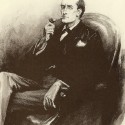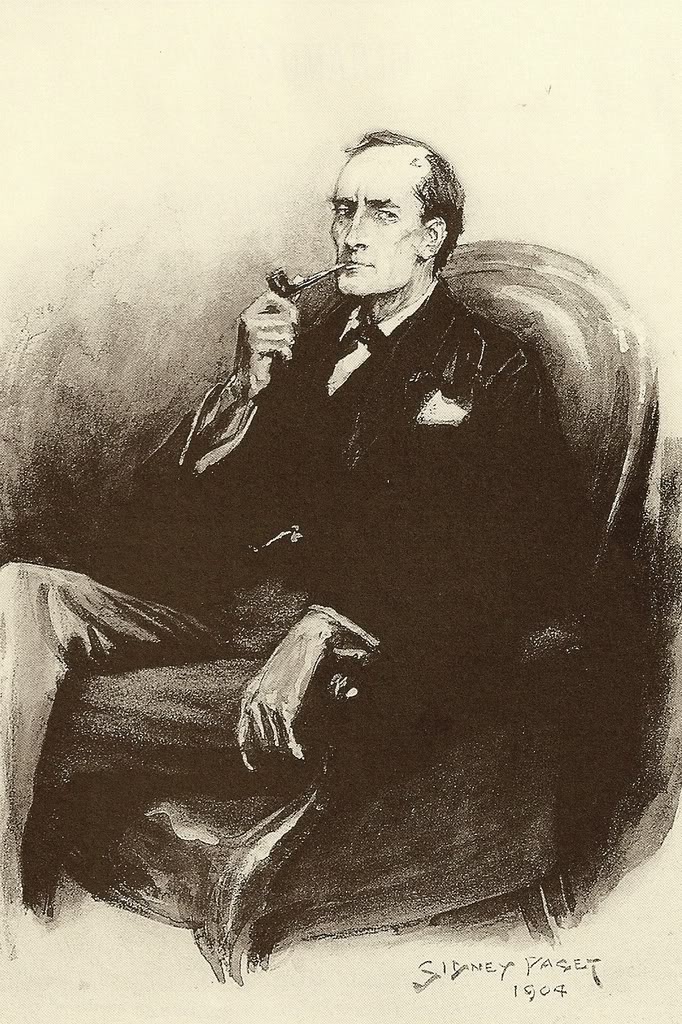A Scion Society of The Baker Street Irregulars

British Coins Central To Holmesian Stories (1993)

Sherlock Holmes as sketched by Sidney Paget, considered the master Holmes portraitist.
We all know who Sherlock Holmes was, the greatest detective of Victorian England in all of literature. I’ll be willing to bet that most readers of this column have also read some, if not all. of the stories that are called by fans “The Sacred Writings.”
How often are coins mentioned in the Holmes stories and what kinds are they?
I’ve read all of the Holmes stories at one time or another, many of them more than once. But I have to confess that, apart from some really famous references, I couldn’t think of more than a few. One of the National Videotext Network Coin Forum members who recently discussed the topic through his computer and modem is Greg Ruby. Greg is an avid Holmes devotee and, not surprisingly, his chosen forum nickname is “Sherlock.”
Greg offered to write down some references to coins found in the Holmes corpus and electronically mailed them to me. I downloaded them and, with his kind permission, would like to share them.
In The Musgrave Ritual, Holmes and Dr. John Watson, his friend and biographer, are cleaning up their quarters at 221B Baker St., when Holmes brings out a tin box of memorabilia from his earlier cases.
After bringing forth some items the box, Holmes tells the tale of the strange ritual that the Musgrave family performs and of some strange happenings at Hurlstone, home of the Musgraves. Holmes has figured out that the riddle is to a hiding place at Hurlstone and has led Reginald Musgrave and the county police to the hiding place of a box.
Holmes told Watson, “Several discs of metal – old coins apparently – such as I hold here, were scattered over the bottom of the box, but it contained nothing else.”
Holmes ponders the meaning of the box and the objects it contains, then speaks. Holmes tells Watson: “These are coins of Charles I,” said he, holding out the few which had been left in the box. “You see we were right in fixing our date for the Ritual.”
In The Red-Headed League, Jabez Wilson comes to visit Holmes. Holmes deduces that Wilson has been to China: “… I see a Chinese coin hanging from your watch-chain. …” Wilson recounts how he has been hired for a strange task and now has an employee running his shop. This shop is near a bank and Holmes theorizes that this new employee is tunneling into the bank. Holmes leads Watson, Scotland Yard and a bank director into the cellar of the bank.
“It is our French gold,” whispered the director. “We have had several warnings that an attempt might be made upon it.”
“Your French gold?”
“Yes. We had occasion some months ago to strengthen our resources, and borrowed, for that purpose, thirty thousand napoleons from the Bank of France. It has become known that we never had occasion o unpack the money, and it is still lying in our cellar. The crate upon which I sit contains two thousand napoleons packed between layers of lead foil. Our reserve of bullion is much larger at present than is usually kept in a single branch office, and the directors have had misgivings upon the subject.”
In The Adventure of the Dying Detective, Watson visit Holmes and finds him near death. Holmes refuses to let Watson examine him and pretends to babble in order to fool the good doctor.
“No, Watson,” said he. “Have you any change in your pocket?”
“Yes.”
“Any silver?”
“A good deal.”
“How many half-crowns?”
“I have five.”
“Ah, too few! Too few! How very unfortunate, Watson! However, such as they are you can out them in your left trouser-pocket. Thank you. It will balance you so much better like that.”
In The Adventure of Wisteria Lodge,” Holmes sends a boy on an errand.
“I am entirely at your service,” said Sherlock Holmes, ringing the bell. “You will show these gentlemen out, Mrs. Hudson, and kindly sent the boy with this telegram. He is to send a five-shilling reply.”
In The Adventure of the Three Garridebs, a con man comes up with a scheme to have Nathan Garrideb leave his quarters looking for another man named Garrideb. Holmes visits Nathan’s home.
“The room was as curious as its occupant. It looked like a small museum. it was both broad and deep, with cupboards and cabinets all round,crowded with specimens, geological and anatomical. … As I glanced round I was surprised by the universality of the man’s interests. Here was a case of ancient coins. … It was clear he was a student of many subjects. As he stood in front of us now, he held a piece of chamois leather in his right hand with which he was polishing a coin.
“Syracusan – of the best period,” he explained, holding it up. “They degenerated greatly towards the end. At their best, I hold them supreme, though some people prefer the Alexandrian school.”
Many other Holmes stories and at least two novels, A Study In Scarlet and The Hound of the Baskervilles, contain references to money or wages. The Annotated Sherlock Holmes contains all of Sir Arthur Conan Doyle’s Holmes stories, with annotations by William S. Baring-Gould. Baring-Gould comments about the coins mentioned in the stories.
This article was originally published in the August 9, 1993 issue of Coin World. Thanks to Coin World’s Editor-At-Large (and 52nd Garrideb) Steve Roach for his assistance in sharing this article with us.
Michael J. Hodder is one of the preeminent numismatic researchers and catalogers specializing in U.S. Colonial coins. A native of Great Britain, he was appointed as the historian of the American Numismatic Association in 1991 and was the co-author of both A Basic Guide to United States Commemorative Coins and The Norweb Collection: An American Legacy, in addition to other works and articles. He had a regular column, Coins in Britain, in Coin World where this article was first published.
